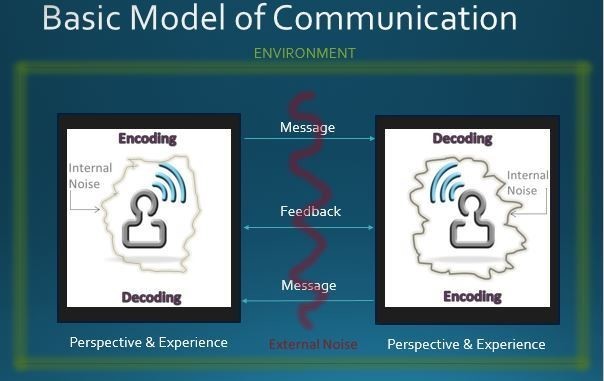Effective communication is still very important in the business world, and very important for us to succeed as employees and especially as effective leaders. What I see more and more everyday is the erosion of effective communication. With all of the texting and instant messaging that everyone participates in, a whole new language is being created.
It becomes more and more acceptable for emails to be sent without them being proofed or reread for missing words. It becomes acceptable to add emoticons in the body of our messages to business coworkers, direct reports, superiors or even customers. But the result of this is a loss or disconnect a lot of times in our messages. So let’s get back to the basics of effective communication.
What is communication? Communication is the process of people sharing thoughts, ideas and feelings with each other in commonly understandable ways. Communication is a two-way street. If you look at this simple model of communication, you realize very quickly that communication is not so simple.

Forgetting about all of the environmental and external noises going on, just the differences in the frame of reference (or the perspective and experiences) of each person involved are so different that a message can get lost in translation quickly.
Do you remember the game in school in maybe kindergarten or first grade called telephone? The teacher would line you up. The teacher would then whisper a message into the first person’s ear. Then that person would turn to the next person in line and whisper the message to them, and this would continue until it got to the end of the line. The last person would repeat the message and it was never the original message.
Effective communication is not as simple as we think. And if employees are not understanding the messages coming from you, how can the organization expect for them to be successful?
How we actually communicate our message may surprise you too. Our actual words only make up 7% of the communication. The vocal part of our message makes up 38% which includes tone, pitch, rate, volume and emphasis. The remaining 55% of the communication comes from our gestures. Gestures are the non-verbal cues both intentional and unintentional that we do during the communication process.
As you can see, there are a lot of factors, roadblocks and distractions that prevent us from communicating effectively. Here are 4 essential skills that you can put into practice right away to help you be a better communicator.
- The first skill is to create an environment of open communication.
- This starts with questioning all of your assumptions and not jumping to conclusions. Remember everyone is different because of our own unique frames of reference. Just because you think you have seen a situation before, doesn’t mean it is actually what you think it is this time.
- You need to encourage open dialogue with your team, and that includes tough feedback directed back at you. If you shut them down because it is something you don’t want to hear like an area you need to improve on, then you will end up shutting down all communication from your team. As a leader, you must be able to dish and receive because we can all make improvements to be better each and every day. If they see you listening to them, they will be more likely to listen to your tough feedback.
- You want to support team involvement by asking for their input when possible. This doesn’t mean to slow decisions down or let a decision be a democratic process, but it helps with team buy-in. You are the leader and make the ultimate choice, but you may discover a new solution or different way of seeing things by listening to your team.
- Trust is at the center of everything we do as a leader. Without trust, we don’t have a team. By keeping an open communication environment, it will help to build your team’s trust with you and each other.
- The second skill is to design clear and concise messages.
- You must know your audience. You don’t want to talk down to them, but you also don’t want to use big words or really complex sentences as your message can easily get lost in translation. This goes back to the telephone game I mentioned earlier.
- Keep your message short and sweet to ensure proper encoding and passing on of your message
- The third skill is managing both the verbal and non-verbal messages.
- For non-verbal, it could be making eye contact when someone is talking to you so they know you are listening as compared to looking around at things happening in the environment.
- Your posture can tell a lot about you. For example, if you are talking with a person and you fold your arms, even if you are smiling, that gives the message of closing off and not listening. Whereas, if you have a more open stance, it is more welcoming and engaging.
- Gestures can happen out of habit, like looking down at your watch, but it could make the person feel like you are in a hurry and so they need to hurry or stop talking.
- Facial expressions can also mislead people. A warm smile and open eyes could show engagement, but a bored look or a distant look could make them feel like they are not being heard.
- And environmental positioning can also set the stage for miscommunication. For example, sitting directly across from someone at a desk or table is a competitive and aggressive position. Whereas sitting next to or caddy corner to the person is more open, supportive and collaborative.
- The verbal aspect is of course the actual words we use, but it is also so much more.
- There is visual, auditory and kinesthetic (or learning with your hands).
- Pitch, pace and volume are in play. Pitch can change the meaning from serious to playful or to a question.
- Pace is speed of the delivery and of course the faster someone speaks it shows they are in a hurry, but people get lost if they can’t keep up and stop listening.
- Volume can be used to talk over people or loud situations or it can represent anger.
- You can also stress certain points by raising your volume for important keywords.
- Or you could lower the volume to draw someone in to pay extra attention to something important.
- Emotion can also have a dramatic impact on your message.
- Passion in your message shows you really care about the topic.
- Maybe a little choking up shows the high impact of the message.
- Or you see upset emotions coming from the other person and that tells you the importance of the message coming to you.
- For non-verbal, it could be making eye contact when someone is talking to you so they know you are listening as compared to looking around at things happening in the environment.
- The fourth skill is listening to communicate or Active Listening.
- Active listening means you are removing all distractions like: phones, computers, paper work or anything you may be working on and listening to the speaker’s verbal and non-verbal’s, and how they are delivering the message.
- Then clarifying, paraphrasing and repeating back what they said to you.
- One practice I do to make sure I am engaging in active listening is to stop what I am doing, remove myself from it, turn my focus to the person and make eye contact. If someone stops by to talk to me, and I am right in the middle of something I can’t just stop, I politely ask them to wait just a moment. I quickly finish up or at least get to a stopping point, and then I turn away and make eye contact to initiate the conversation
Effective communication will remain a critical and needed tool for all leaders, and you can start putting these skills into action right away. Take the time to focus on the art of effective communication and see your team and organization improve from it.
Brandon Brazeel, MBA, SPHR, SHRM-SCP
Chief People Officer


